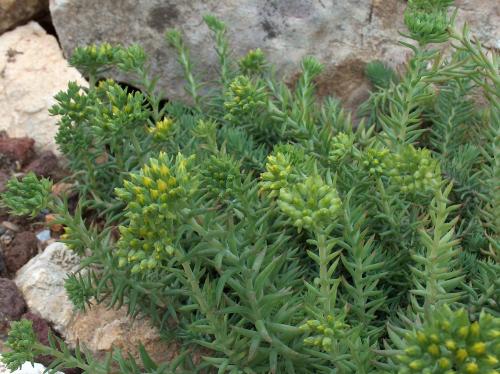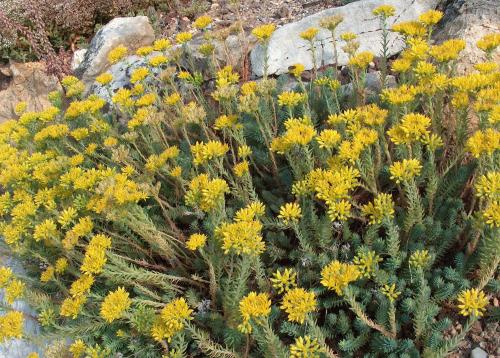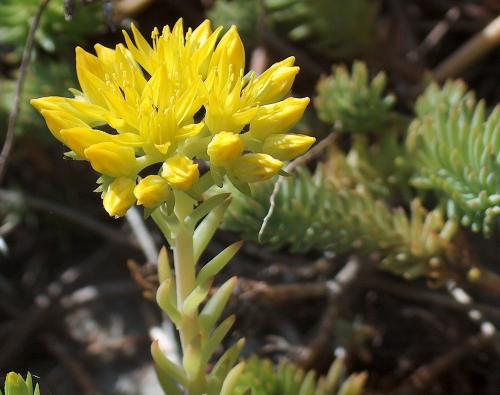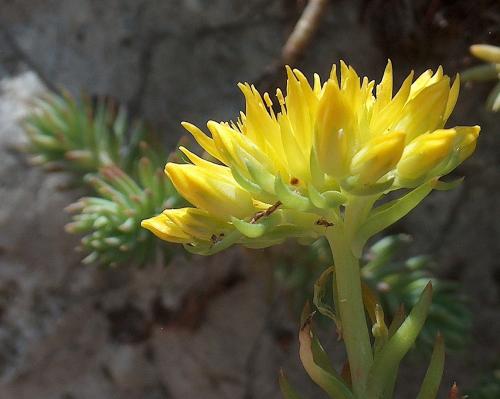MONTANUM (Songeon & E. P. Perrier) Grulich, 1984
Synonyms :
Sedum montanum Songeon & E.P.Perrier (1864) / Sedum rupestre ssp. montanum (Songeon & E.P.Perrier) P.Fourn. (1936) / Petrosedum rupestre ssp. montanum (Songeon & E.P.Perrier) Velayos (1989) / Sedum ochroleucum ssp. montanum (Songeon & E.P.Perrier) Webb (1961)
Sedum sulfureum Legrand (1869)
Distribution : Pyrenees, Appennines, Alps (Austria, Switzerland, Italy, France), Spain.
Description (according to IHSP, 2003) :
Glabrous perennials, sterile shoots ± procumbent, rooting.
Leaves imbricate, alternate, linear, mucronate, terete, basally spurred, 10 - 15 mm, green or glaucous.
Inflorescences : Flowering branches erect or ascending, 10 - 35 cm, inflorescences terminal corymbs with 3 - 6 branches, densely glandular-pubescent, erect and flat-topped in bud, branches scarcely recurved, bracts leaf-like.
FIowers (5- to) 6- (to 8-) merous, subsessile, sepals basally connate, triangular, long acuminate, densely glandular-pubescent, 5 - 7 (-10) mm, petals free, oblong, 8 - 10 (-12) mm, yellow, spreading, filaments yellow always glabrous, anthers yellow.
Cytology : 2n = 34, 51,68
See also P. thartii.
Ray Stephenson (Sedum, Cultivated Stonecrops, 1994, p 120)
Vegetatively this species is variable and indistinguishable from small decumbent forms of Petrosedum reflexum or small forms of P. ochroleucum to which it is very closely related (Petrosedum characteristics, fig. 2) Normally creeping stems are clothed with imbricate, apiculate terete leaves (Petrosedum characteristics, fig. 1d). Flowers are usually 6-partite and always golden yellow. Several contrasting leaf-colour forms are common in gardens, including the plant depicted by Evans (1983) as "Sedum 'Forsterianum' of Gardens," which is merely a green, more upright form of P. montanum.
Habitat : As the name suggests, this is an alpine species from over 1000 m (3000 ft) in France, Switzerland, Italy, and former Yugoslavia.
Main points of distinction : When not in flower, Petrosedum montanum is likely to be more creeping than P. rupestre, but identical to smaller forms of most species in this group. Leaves are much narrower than those of P. sediforme and much stiffer than those of P. forsterianum. The only true test is to observe inflorescences as they grow : they are upright-facing throughout their growth, not reflexed in bud, and flowers have glandular hairs on large sepals. Vegetatively, this species is almost identical to P. ochroleucum, but spreading petals are golden yellow on a flat-topped inflorescence.
Variation : Leaf colour varies enormously: green, brown, and grey forms are in cultivation - some glaucous, some glabrous, and others with individual leaves glaucous below and shiny glabrous above. Some forms with clusters of leaves at the ends of stems superficially resemble P. forsterianum plants. However, P. montanum, has stiff leaves, and its stems are not usually shaggy with dead leaves. 't Hart (1978) noted diploid (2n = 34), triploid (2n = 51), and tetraploid (2n = 68) plants.
Horticulture : This species is suitable for rock gardens or raised beds. It is fully hardy in temperate zones, but may suffer in summers where day températures over 25 °C (77°F) occur for several consecutive weeks.
Plant in cultivation (collected by E. Barbier, Notre Dame de la Salette (France - Alpes - Isère) alt.1750 m)
Inflorescences erect and flat-topped in bud :

June 2009 :

May 2012 :

